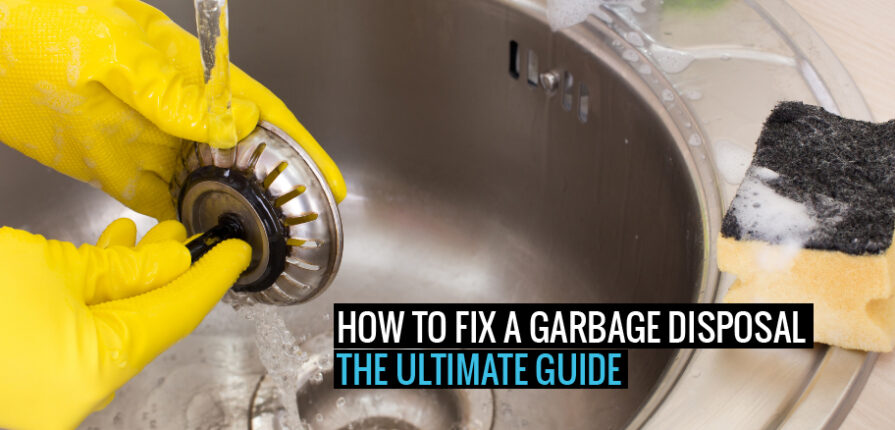Garbage disposal units are a fantastic kitchen convenience, but like all brilliant gadgets, they can develop issues with time. The majority of garbage disposal issues may be resolved without calling a plumber. The garbage disposal problems—leaking units, units that turn on but won’t spin, units that won’t turn on at all, and clogs will all be covered in this article. We’ll conclude by outlining the various items you should never throw down your garbage disposal. Let’s set a quick golden rule on how to fix a garbage disposal before we get started:
keep your hands away from the garbage disposal. Always keep this in mind; otherwise, you can find yourself searching for “garbage disposal injury troubleshooting” on Google.
Also read: Top 10 Questions to Ask a Plumbing Service Before Hiring
Complete Guide on How to Fix a Garbage Disposal
Leaking Garbage Disposal
Finding the leak is the first step when you find how to fix garbage disposal because there are many potential reasons for these leaks. The unit’s bottom, the sink flange (where it attaches to the sink), the inlet hose (which connects to the dishwasher), and the drain line (which connects to your drainpipe) are the four main places where leaks occur.
Here’s a quick hack you can employ if you can’t get a good look at the leak’s source. You should plug your sink and add a few inches of water to it. To tint the water, add some food coloring. Pull the plug now and look underneath the sink.
The Sink Gasket
The seal surrounding the sink flange can become damaged over time or become loose, which is one of the more frequent reasons for garbage disposal leaks. Re-sealing the flange should fix the garbage disposal leak if it is coming from the region directly beneath the sink and not from one of the hoses running along the side of the appliance. It’s a job that requires some effort. Both plumber’s putty and a flathead screwdriver are required.
The Drain or Inlet Lines
Around the inlet (to your dishwasher) or drain lines is another typical place for garbage disposal leaks. Where the lines connect to your waste disposal unit, this is typically brought on by a worn-out gasket or loose screws. Simply check the screws and the connection to fix the garbage disposal.
If they appear to be tightly sealed, you likely have a worn gasket, which is easily replaceable at any hardware or house maintenance store.
The unit’s bottom
You’re probably looking at a complete replacement if water is leaking out of the bottom of your garbage disposal appliance. The “reset” switch and the seal next to the power supply are frequently the sites of leaks. All of them are brought on by leaks or deteriorated seals inside the appliance. Simply purchasing new garbage disposal is a less expensive and more practical solution.
The garbage disposal is humming but not spinning
The most likely reason for a garbage disposal unit’s motor to start humming when you turn it on, but the blades won’t start spinning is a blockage in the blades. You’ll try to manually turn the blades to loosen the obstruction as you attempt to fix the garbage disposal unit.
The garbage disposal won’t operate
When you switch on the garbage disposal and there is no sound at all (no motor sounds or humming), one of the following problems may be present.
- The plug for your garbage disposal is not in.
- Resetting your waste disposal is necessary.
- Your garbage disposal unit’s control circuit has been turned off.
- The switch that powers your disposal machine has faulty wiring.
- It’s time to get a new garbage disposal system.
Unable to drain the garbage disposal
When garbage disposal won’t drain, a clogged pipe is to blame. Some people might think the blockage is in the appliance itself. Typically, this is not the case. The p-trap (the u-shaped pipe under your sink) or the discharge pipe is usually blocked (the pipe that goes from your disposal unit to your drainpipe).
The unit must first have all power turned off. After that, carefully remove the p-trap and the discharge pipe. The key is to go gently and to always keep a bucket beneath to capture any water that eventually leaks out of the pipe fittings.
You should be able to see the impediment in one or more of the portions once the pieces have been taken out. Rinse the components after scraping away all of the solid matter.
There can be a blockage deeper in your plumbing system if you can’t locate any type of obstruction in any of the pipe segments under your sink. If so, you can either hire a plumber to fix the garbage disposal or try to reach further into the lines using an auger.
Reattach the p-trap and discharge pipe after you’re done, then test the faucet.
What not to throw in a garbage disposal unit
The small food bits that are left on your pots, pans, and plates can be cleaned up by garbage disposals. However, a lot of households develop the practice of using their garbage disposal units as literal trash cans. The improper items will eventually cause a clog in the disposal, which is no fun.
Your garbage disposal unit may have issues with grease, fibrous foods, and hard objects (bones, shells, and pits). These should be instead discarded in the trash.
Conclusion
The majority of waste disposal issues are simple to resolve with some basic home tools and some effort. You should always give a few things a go before calling a plumber. Preventative maintenance is the homeowner’s most effective tool. You may prevent clogs by being cautious about what you put in your disposal unit.

